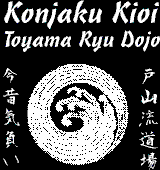 |
Toyama Ryu Batto Do Konjaku Kioi Dojo (Ancient and Modern Fighting Spirit Dojo) |
5980 66th St N Suite M St Petersburg FL 33709 Email: info@toyama-ryu.com Phone: 727-329-9679 |
|
Home
|
Tameshigiri 試し - Test Cutting
Basic ConceptTameshigiri is only one aspect of swordsmanship. It teaches the student how to strike a target effectively. Students train for months in the basics of Japanese Swordsmanship before starting tameshigiri. This is for both safety and the fact that cutting targets without kihon is meaningless. Please get professional training and the proper equipment before attempting tameshigiri! Tameshigiri is just one aspect of Japanese Swordsmanship and should only be done as part of a well rounded curriculum. Do not perform tameshigiri using an expensive antique katana. You
can bend, scratch, chip, and/or discolor your blade. Old tsuka
(handles) become brittle with age and can shatter. Clean you katana immediately after tameshigiri. Wipe off all debris and use plenty of choji or camellia oil to keep your blade from rusting. Tap the koiguchi (mouth of saya) to get any debris out of the saya (scabbard). If there is any debris on you blade after cutting, remove it before putting your sword in the saya. Some schools recommend cleaning you katana before putting it back in the saya after tameshigiri. If the target comes off the stand, step back, move the kissaki (tip) behind you, and allow someone else to put the target back onto the stand. This should also be done if a large piece of the target was cut and you want to re-cut that piece. Tameshigiri TargetsWe recommend new tatami omote and bamboo targets for tameshigiri. Tamshigiri is not Japanese Swordsmanship. It should be done as part of a comprehensive swordsmanship curriculum to provide feed-back on the effectiveness of cuts. Tatami omote can be purchased from Nihonzashi and Mugen Dachi . Tatami makes a fairly tough target material compared to beach mats and goza. New tatami eliminates the variability in targets and the extra staples, dirt, tape, and other debris you get with used tatami. There are many species of bamboo available with varying degrees of hardness. We recommend using bambusa textilis since it has a reasonable hardness, fairly thin walled, and is non-invasive. We use bambusa textilis gracilis (Graceful Bamboo) which is a clumping bamboo growing up to 25’ tall with 1” stalks. |
Copyright © 2006 by Konjaku Kioi Toyama Ryu Dojo, All rights reserved.
Samurai Swords
Iaito (Practice Swords)
Shinken (Cutting Swords)
Wakizashi (Short Swords)
Tanto (Daggers)
Japanese Weapons
Maintenance
Uniforms
Sharpening
Sword Repair
Martial Arts
Dictionary Your Name in Japanese
Dojo Stories
Tatami Targets
